
General Care
Grooming
What Items You Will Need
Socializing and Training Your Puppy
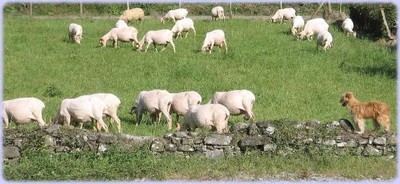
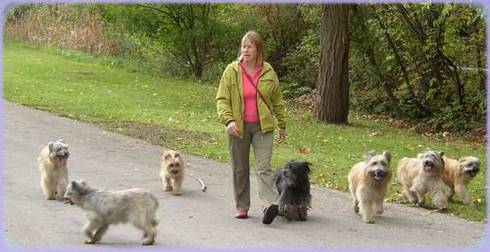
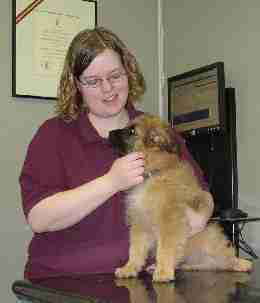
For more information on health issues and Pyr Shep care visit our Breed Info page.
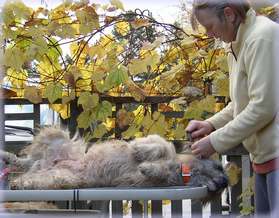
If you are showing your Pyr Shep, you only need to
ensure his coat is clean and tidy for the show ring. No trimming or scissoring
is required. It is important to encourage showing the breed in its natural
state! Many long-coated breeds lend themselves to over-grooming and one should
refrain from this. Most important is that you should not bath your
Pyr Shep unless absolutely
necessary. Bathing his coat will make it soft and prone to matting.
Perhaps a minor trim of the hair around his feet will bring into the house
a little less dirt but that is usually sufficient.
Brushing can be done as little as possible and the Pyr Shep will retain
his charming rustic appearance. Combing or brushing once a month is
more than sufficient to keep the coat clean. If you would prefer less
maintenance and would like you dog to cord
then only comb over the shoulders and the head--the coat will naturally cord
on its own. Teaching your dog to lie still on a table is helpful when grooming.
This behavior will make the grooming process a pleasure for everyone involved
as your puppy learns patience and tolerance. The amount of grooming
this breed requires can range from very little to quite a lot and this depends
on the owner.
In the winter a combination of mild weather and snow will inevitably cause
snowballs to accumulate on your Berger's legs. During your walk you
can pull off the larger ones with your hand but when you return home what
can you do??
I use a rubber curry brush purchased at a agricultural supply store and
just rub the snowballs briskly. The soft pointed rubber teeth will
break apart the snowballs. I prefer the brush that is designed as a
glove so my own gloved hand can fit into it. Of course, clipping the
length of the leg hair also helps. By the Springtime the hair will
have grown back.
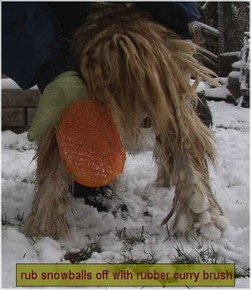 I don't know of any Pyr Shep that likes to have his nails clipped, but
with firmness and persistence they will learn that is something they must
endure. Make sure you do not cut through to the quick of the nail bed
as this will put your pup off for a long while. But, if you
do, don't fuss and just continue on. We all make mistakes and luckily
our dogs forgive us without hesitation. AND DON'T FORGET THE DEWCLAWS
ON HIS BACK LEGS! With the puppies I start off by having another person
just hold them in the air while I clip the nails. As they get older
and bigger I ask them to lay on their side on the floor (after a long walk
is a good time) and will just clip the nails on one foot then do the next
foot later on or the next day. Take you time and after a few months/years
then you will only need to lift their paw off the ground, clip, clip, clip,clip
and there will be no fussing at all. The same goes for grooming with
a brush. Start off with very, very short sessions making sure that
your puppy is not allowed to struggle or run away from you until he is sitting
or laying still. A short little brushing session, then sit quietly
for half a minute, then allow the puppy to leave you. Eventually they
will enjoy your coifing and fussing with a smile on their face.
I don't know of any Pyr Shep that likes to have his nails clipped, but
with firmness and persistence they will learn that is something they must
endure. Make sure you do not cut through to the quick of the nail bed
as this will put your pup off for a long while. But, if you
do, don't fuss and just continue on. We all make mistakes and luckily
our dogs forgive us without hesitation. AND DON'T FORGET THE DEWCLAWS
ON HIS BACK LEGS! With the puppies I start off by having another person
just hold them in the air while I clip the nails. As they get older
and bigger I ask them to lay on their side on the floor (after a long walk
is a good time) and will just clip the nails on one foot then do the next
foot later on or the next day. Take you time and after a few months/years
then you will only need to lift their paw off the ground, clip, clip, clip,clip
and there will be no fussing at all. The same goes for grooming with
a brush. Start off with very, very short sessions making sure that
your puppy is not allowed to struggle or run away from you until he is sitting
or laying still. A short little brushing session, then sit quietly
for half a minute, then allow the puppy to leave you. Eventually they
will enjoy your coifing and fussing with a smile on their face.
WHAT SHOULD YOU FEED YOUR BERGER DES PYRENEES?
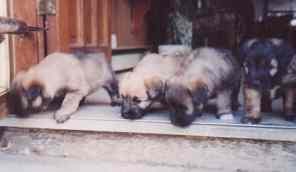
Our puppies are raised
in our home and integrated with our stable pack of adult dogs at the age
of 4-5 weeks old. Until that time the puppies and their mother are raised
with the care of respecting what Mother Nature dictates. The puppies
are always being managed by their mother, then by the other dogs, and then
by us. From the time they are born they are being taught limitations
and boundaries by everyone. We have watched and studied how our mothers
raise their pups and the reactions of the pups in their environment as they
grow. Our puppies are kept warm and fed by their mother in a quiet
area of our home for the first 3 weeks. They are handled daily but very
minimally to respect the natural bond of the mother and puppy. Their
bedding in the large whelping box is cleaned daily and at 4 weeks of age
they are moved to a large pen in the centre of our busy household. This
is when our pack of dogs and ourselves become a bigger impact on the puppy's
management. At the same time, 4-5 weeks old, they are
given the option of going out of doors with the adult dogs. By 5.5
weeks of age the puppies naturally go to the door to go outside with the
other dogs. They have gradually become accustomed to the different tones
of our voices as well as all the vocalization of the other dogs. I
create an environment that promotes their natural curiosity as a curious puppy
will build confidence as it explores and conquers the world around it and
these experiences will aid in maturity. Playing with a puppy with toys
is a lot of fun for them but you also want to understand that fun is fun
and excitement and does not promote mental stability, growth and maturity.
The puppy must also educate his mind through your guidance of his behavior
and exploration of the world in a calm state of mind.
Bringing Your Puppy Home
You will receive
your puppy no earlier than nine weeks of age. I feel nine to ten weeks
of age is an ideal age for the puppy to leave his/her mother and littermates
and start life with his new family. The puppies benefit a great deal
from spending time with their mother as well as with our whole pack.
At 4 weeks of age they are fully integrated into the Chaparral pack and learning
how to be a well-mannered dog. We have started their house-training
and their day and nighttime rituals to help make their transition to their
new families easy for everyone.
No matter what the age, it
will take two to three weeks for your puppy to learn to adjust to his new
owners. You must observe your puppy and determine his
character and temperament and, if necessary, modify certain behaviors to
your advantage. During these weeks the puppy is learning to adapt
to the sights, sounds and smells of his new surroundings--a new house, a
new yard, a new environment outside of the property lines and sometimes new
pets that he is also expected to live with. Besides his new environment
he is also learning and adapting to his new human family and the odd and confusing
ways we humans run our lives. On top of all these changes to his young
life he is also expected to learn to sleep by himself instead of cuddled
up with his littermates, learning to go to the bathroom in a new outdoor
area, and learning some basic good manners to be an accepted member of the
family. All these new experiences are a lot of work for a baby puppy,
or an adult dog. A Pyr Shep puppy is very aware of his environment and
very affected by his environment so it is important to keep his life simple
and calm until he has adjusted and started to bond with his new owners. Your
new puppy has a lot of work to do so don't add to his workload by pushing
the limits of his endurance. Make the first three
weeks of his life as uncomplicated as possible. He does
not need to meet new friends or be traipsed around to every puppy class or
park. There are many, many years ahead of your puppy to start training
tricks, etc. DO NOT RUSH! Teach him/her new name, the toys
it can play with, the command "no bite", "off", his housetraining and
leash training. As much as it is tempting to show off your new puppy
to your friends and start taking the puppy out and about try to limit such
new experiences to the home, property and surrounding area where the puppy
is already becoming comfortable with his surroundings. Once the puppy exhibits
signs that he is comfortable and confident within his new environment you
can start to introduce him into new situations and adventures. Always
be aware of what your puppy is saying to you and respect his wishes.
Do not allow other people to tell you what you should be doing with your
puppy--you know him/her best.
If you feel your puppy
is going to be overwhelmed in a situation, like a large family gathering,
it is sometimes best to just put the puppy away in a place where he feels
safe and just allow him to observe all the goings-on instead of participating
in them. They learn a lot through observation and be certain they will
always have their eyes on you to see how you are managing the environment.
Dog crates, plastic or wire, are excellent training tools.
If he can hear the goings-on or see them from a distance it is enough information
to digest so the large pens that you can purchase are also a handy tool to
use when visiting friends. If you do not have time to be with the puppy
and show him the behavior your expect from him in any given situation then
it is best if the puppy is not left to his own devices and to put the puppy
in quieter area of the house until you have time to deal with him.
Like babies, you shouldn't let a puppy become overly tired or over-stimulated
or expect him to put on a good performance for everyone. They too will
become cranky and irritable and because they have already communicated to
you at one point that they have had enough and you have ignored them then
they start to lose confidence in your abilities to understand them.
Despite all the puppy's efforts to be alert and stay with you it is up
to you to know when he should be resting. Puppies sleep a lot, if
allowed.
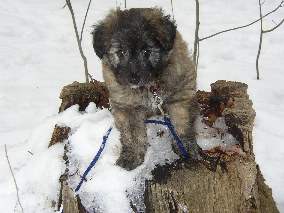
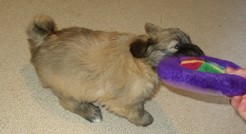 Graduating from an open meadow, you can take your
puppy into more dense overgrowth such as forests and fields. Running
through dry leaves with your pup becomes a terrific game to play while encouraging
him to watch your actions and joyful behavior. Letting your puppy chase
after you promotes his motivation to follow. Coming upon fallen logs
or streams arouses his curiosity and lots of encouragement and praise should
be given for his efforts to overcome these obstacles and keep up with you.
Graduating from an open meadow, you can take your
puppy into more dense overgrowth such as forests and fields. Running
through dry leaves with your pup becomes a terrific game to play while encouraging
him to watch your actions and joyful behavior. Letting your puppy chase
after you promotes his motivation to follow. Coming upon fallen logs
or streams arouses his curiosity and lots of encouragement and praise should
be given for his efforts to overcome these obstacles and keep up with you.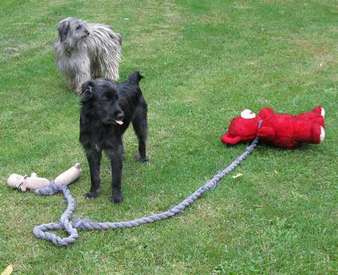 The best tugging
toy is a stuffed animal attached to a soft rope.
The best tugging
toy is a stuffed animal attached to a soft rope.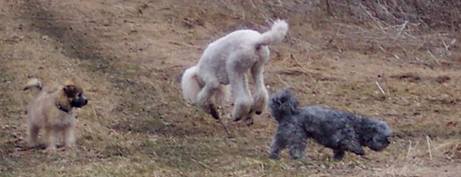
At 10 Weeks
Now that the puppy is confidently following you along
you can start to challenge him. You've been bonding with your puppy
for a couple of weeks now and he is getting accustomed to your body language
and learned the tones of your voice so now you can start to challenge his
senses a little. Follow the same program as at nine weeks,
but make it a bit more challenging. Occasionally hide from the puppy when
it is distracted in the woods. Watch the puppy - does it notice that
you are missing? If it does and starts looking for you, come out from hiding
and praise it profusely. If the puppy does not look for you, toss a pebble
to make it notice you are missing, then call from your hiding place. When
the puppy starts to look for you, come out and praise it. This will teach
the puppy, it is repeated time and time again, to watch you when you are
out in the woods instead of you constantly watching the puppy. Play this game
with the puppy over and over again until you find it nearly impossible to
hide because it is always watching you. Don't spend your entire walk calling
the puppy's name. Being able to rely on your dog taking the responsibility
of staying with you and keeping his focus on you is an attribute you will
appreciate when he is older and is one that he must learn as he is growing.
Please note that this only works effectively if the puppy is trained
at an early age.
When meeting strangers
on your outings we hope they will first ask to pet your puppy. But,
in most cases, they do not ask but just assume it is appropriate. This
is unfortunate because a large strange hand coming directly towards the
puppy's head will usually make him shy away. It is best to allow your
puppy to stand quietly beside you or hold your puppy while you carry on
a conversation with the people (usually explaining what breed the puppy is)
and ask the people to just wait a couple of minutes and allow the puppy to
make advance and sniff the new person before they touch the puppy.
While standing conversing with the stranger your puppy is starting to adjust
to the stranger and gaining his confidence through your casual air.
When you feel the puppy is relaxed, or he gives you an obvious signal, such
as struggling to come out of your arms or looking at the stranger in the
face, put the puppy on the ground or allow him or her to now greet the new
person. The new person may then bend over and offer a friendly hand.
Never allow a stranger to pick up your puppy. That is far too intimate
a gesture. The puppy will usually, quite happily, greet the stranger
and then cut off the greeting while the puppy is still in a joyful frame of
mind and walk away. Always leave your puppy wanting more. If
you wait for this new experience to take a negative turn then that lesson
of not wanting to interact with strangers has just been learned and it will
take you a long time to undo it. You can encourage the greeting
or just allow the puppy to be part of the group thus it learns that other
people (and sometimes their dogs) pose no threat. It is just as acceptable
to tell the stranger to just ignore the puppy if the puppy is telling you
both that he is uncomfortable and does not want to be touched by strangers.
Try to keep the encounter brief so the puppy happily trots away with you
and has experienced a positive encounter. Always leave with the puppy wanting
more!
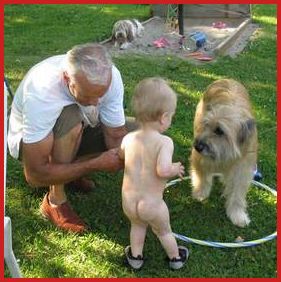
For the first 2-3 weeks
it is best to keep a low profile with the puppy. Although the desire
is to show off your new family member to all your friends is strong, it is
a good idea to first earn the trust of your puppy. If you take the
puppy to stressful venues and it has not had enough time to start bonding
with you then you are letting your puppy down and the puppy feels that it
has nobody that it is by itself and has nobody it can rely on. If you
watch your puppy carefully and learn how the puppy communicates it will show
you when it is ready to explore the world further. It only takes time
and patience to build a solid foundation of trust and respect--be patient!
Socializing your pyr shep
puppy does not need to involve handling by strange people. What the
Pyr Shep puppy needs to experience all the sights and sounds of our world
and his world. It is enough for him to see people, see other dogs, see traffic and other strange people activities.
He doesn't need to be thrown into
the thick of things. Let him stand on the sidelines, assess
the situation and become relaxed being there then walk away. Remember,
the Pyr Shep is very sensitive to his environment--you are in control of
his environment! If you worry how he will react, he will react worried!!
Don't worry, relax, feel confident knowing that you will not put your puppy
in harms way and the puppy will feed off of your confidence. If you
are confident then the puppy will be confident.
Meeting children should be a privilege for
your puppy or dog. The dog should not be allowed to go up to a child
unless he is in a calm state of mind, well-mannered and you tell the dog
it is OK to do so. Your dog should show his respect with his head and
ears lowered and a calm disposition.
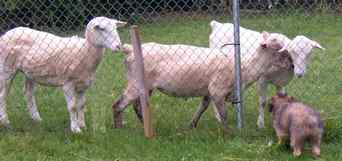 At 12 Weeks
At 12 Weeks
Take a trip to the farm. Let the puppy see cows, horses,
chickens and whatever else you can find. This time you can keep
it on leash. Make sure the puppy is safe from the animals and can get
close enough to sniff them. Be sure to have a positive attitude and
act nonchalantly, as if this is what every 12 week old puppy does. All dogs
should be respect for other animals and should never be allowed to harass
them.
A properly socialized puppy
is far more likely to treat a new experience or object with curiosity and
will want to discover and explore it. If the puppy is fearful then
do not belabour the point. Do not praise fearful behavior such as barking
or lunging but show the puppy that you are in control of the situation and
in control of him and make it seem to him that you have decided to end the
confrontation (or end his barking) by distancing yourselves to a point
where the puppy feels more secure and there you can ask him to sit down
and be quiet. If your puppy is off-leash and wishes to place itself
quietly off in the distance then allow the puppy to do so. The more
you try to coax him and focus on him the more suspicious he will become and
then he will start to worry, you will start to worry and nobody is happy.

At 13 Weeks
Take the puppy into town on a leash. This should
be a short outing - perhaps 10-15 minutes as this outing is an exercise for
his mind moreso than his body. Walk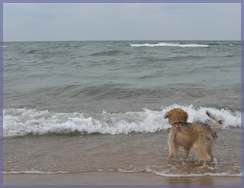 on a main street with light to moderate foot traffic. The puppy should
see and hear people walking, bicycles, delivery people, etc. Praise
the puppy with a "Good Dog" for positive behavior but if he is showing nervousness
try to keep the puppy walking forward and not allow him to dwell on what
it was that made him nervous in the first place. When you get back into
the car pile on the praise for the puppy's remarkable feats of courage.
Try to be aware of what the puppy is seeing and smelling from his point of
view. Often what we take for granted is missed by our suppressed senses
but is very blatant for a puppy. Don't forget to take the puppy on
his regular romp as well as this daily romp should also be a great place where
he can relax and enjoy an outing with his most favorite person in the world--YOU!
on a main street with light to moderate foot traffic. The puppy should
see and hear people walking, bicycles, delivery people, etc. Praise
the puppy with a "Good Dog" for positive behavior but if he is showing nervousness
try to keep the puppy walking forward and not allow him to dwell on what
it was that made him nervous in the first place. When you get back into
the car pile on the praise for the puppy's remarkable feats of courage.
Try to be aware of what the puppy is seeing and smelling from his point of
view. Often what we take for granted is missed by our suppressed senses
but is very blatant for a puppy. Don't forget to take the puppy on
his regular romp as well as this daily romp should also be a great place where
he can relax and enjoy an outing with his most favorite person in the world--YOU!
At 14 Weeks
Take a trip to the beach
or some other place the puppy has never seen. Perhaps the local grade
school front lawn just when all the children are pouring out. Let the puppy
stand and watch all the activity without direct contact with all the children.
It is important for the puppy to see and assess the situation before experiencing
any negativity from a crowd of children. Walk the puppy away from the
activity with an air of confidence then praise the puppy when you return
to the car. This exercise can be repeated, not too often, and eventually
the puppy will become accustomed the all this flurry of activity.
Do not allow a puppy to bark at children as that is being very rude on his
part.
Pyr Sheps have remarkable
memories and each new experience is retained for many weeks so it is not
necessary to expose a puppy daily.
 At 17-21 Weeks
At 17-21 Weeks
This is a bad time to subject your puppy to stress
such as airplane trips, a visit with the veterinarian, a boarding kennel
or any other threatening situation. Many puppies are very fearful at
this age and this should be a quiet time in their lives.
In general, Pyr Sheps do
not enjoy the company of other boisterous dogs which are often not under the
control of their owners. I recommend exposing your puppy to the presence
of other dogs without direct interaction. It is not necessary or desirable
for your puppy to have doggie playtime or go to doggie daycare. Until
the puppy has learned to react to the presence of other dogs in a positive
manner, his first reaction is often one of fear which will only grow into
aggression if left to his own devices. Your puppy needs to know he
can trust your good sense. Teach your puppy to sit calmly by your side
and ignore the other dog(s). Discourage the other dogs from approaching
your puppy unless you are absolutely sure that the other dog will behave
calmly and quietly around your puppy. Once your puppy realizes that
you are in control of his surroundings and that there is a safe option available
to him he will not feel the need to react in a negative manner like snapping
and barking at the other dog. As the puppy grows up and matures he
will learn he can count on your good sense to protect him and will eventually
learn that strange dogs are not the threat he once perceived them to be when
he was a wee little thing. He will then be comfortable in meeting strange
dogs, or better yet, ignoring them completely and allowing you both to continue
on your walks without any fuss. He may even want to have a little
play with another dog.
At 20 Weeks >
Puppy socialization classes are not necessary to raise a well-mannered
and stable dog. If you own a Pyr Shep you should already be a person
capable of teaching basic obedience skills. If you are not
in control of how a class is run or are not confident enough to stand up
for your puppy or to a trainer then you should not attend. The Pyr
Sheps take many years to mature and there is nothing absolutely necessary
that needs to be learned by the puppy under a year of age other than to respect
and enjoy the company of people, have good manners out in polite society
and become an absolute joy to own. Relax and enjoy the first year with
your puppy then you will have many, many more years of pleasure ahead of
you.
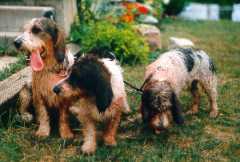
DO NOT
FORGET THAT A TIRED PUPPY IS MORE LIKELY TO BE A
WELL BEHAVED PUPPY! THESE LITTLE DOGS
NEED AT LEAST ONE HOUR WALK EACH DAY
TO BURN OFF EXCESS ENERGY....................then
you're left with a dog with manageable energy! Many behavior problems
are a result of inadequate exercise for this active breed.
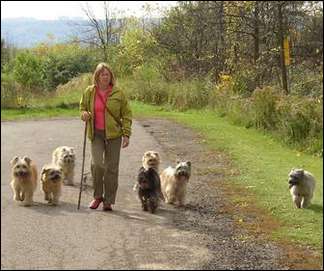
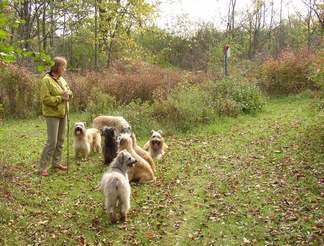 When I am walking our dogs and we see
another pedestrian or dog walker coming towards us I always call our dogs
over to one side and ask them to "sit" or "lie down" and "stay" &
"leave it" so my dogs will ignore the walker & his dog. We wait
for the other person to walk by then continue on our walk. If I have
a very young puppy, <3months, I will often just pick the puppy up and
hold him in my arms.
When I am walking our dogs and we see
another pedestrian or dog walker coming towards us I always call our dogs
over to one side and ask them to "sit" or "lie down" and "stay" &
"leave it" so my dogs will ignore the walker & his dog. We wait
for the other person to walk by then continue on our walk. If I have
a very young puppy, <3months, I will often just pick the puppy up and
hold him in my arms.
These actions show your
dog what good manners are expected in any given situation. He is not
bothering people that do not have a dog, and he is learning to listen to
you, to be patient while awaiting further instruction as well as developing
confidence in your ability to take care of his well-being while looking out
for his best interests. He is also learning that strange people and
dogs are not to be feared and that you do not need his protection, but instead,
you will protect him. Never allow your puppy to try to figure out how
he should react to a person, another dog, or any new situation. You
should always show him how you want him to behave. Practice makes perfect.
If you having your puppy or adult dog continually practice behavior that
demonstrates good manners then the dog will eventually perfect this behavior
and it will become the norm for him. If you allow your puppy or dog
to continually demonstrate fearful and aggressive behavior then you are allowing
your dog to practice this undesirable behavior and unfortunately, he will
only get good at this as well!!
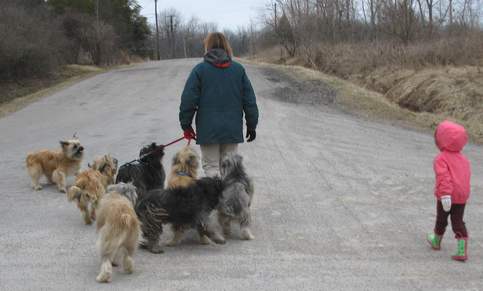
Don't allow your dog(s) to lead YOUR walk. They must earn their good behavior before they are allowed off their leash or released from a heel position. Set off on YOUR walk by inviting your dog to join you, not by following the dog on HIS walk. |
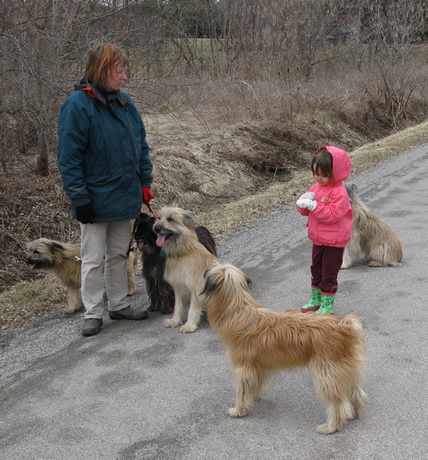
Sometimes their patience is tested when my Granddaughter has an interesting story to relay. This exercise of patience is also establishing good manners and a respect for all people, no matter what their size. |
SO, WHAT DO YOU NEED TO KEEP YOUR PYR SHEP PHYSICALLY FIT and YOURSELF
COMFORTABLE?
 Your puppy will need a flat buckle collar or flat adjustable clip collar and
a six foot leash.
Your puppy will need a flat buckle collar or flat adjustable clip collar and
a six foot leash.
Your Pyr Shep needs to be exercised rain or
shine so be prepared. These are terrific boots that I own and highly recommend.
In the U.S.A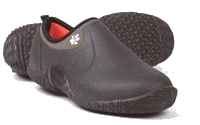 . http://www.muckbootcompany.com/
. http://www.muckbootcompany.com/
A handy little boot for the wet
grass.
My personal favorite full-sized boot is: 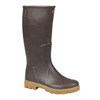
http://www.lechameau.fr
or http://www.lechameauusa.com
A walking partner, especially one with a well mannered dog, will be an
excellent socialization exercise for a puppy, as well as make the time fly
by chit-chatting!
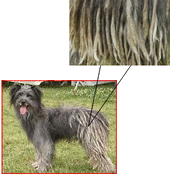 If you wish to have his coat cord then visit our Coat Care Page.
If you wish to have his coat cord then visit our Coat Care Page.  Either of these types of metal combs will keep his coat in order if
you comb on a weekly basis.
Either of these types of metal combs will keep his coat in order if
you comb on a weekly basis.
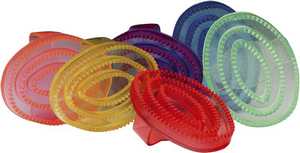 Search for "curry brush" or
Search for "curry brush" or 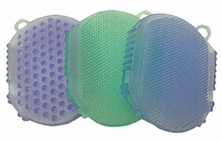 "gel scrubbie curry comb" for the removal of wintertime snowballs.
Or, they are wonderful for massaging your best friend.
"gel scrubbie curry comb" for the removal of wintertime snowballs.
Or, they are wonderful for massaging your best friend.
If just dealing with the snowballs and mud is too much then you can outfit
your pyr shep with a protective pair of pants 
These waterproof pants from Muddy Mutts work well. THE MOST
IMPORTANT THING IS TO GET YOUR PYR SHEP OUT FOR EXERCISE.
Another invaluable item I own is a pair of YakTraks. They make walking
on ice as easy as walking on snow. Great traction!
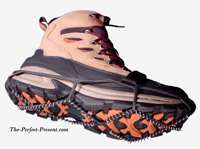
(courtesy ThePerfectPresent.com)
Any type of dog nail clippers
are suitable. You can use the clippers or the electric type which sands
the nail down. Start a puppy by clipping his nails when he is exhausted
from a long walk. Lay him on his side, tell him to "stay" still, clip
the nails on one foot, then praise, and leave the other feet until the next
day. It won't be long before you'll be able to tackle all four feet
at once with no struggle. Always remain very calm and do not talk excessively
to the puppy except to reinforce "stay" still.
 I've found that they gravitate toward this type of
"donut" bed. A metal or plastic
crate is good for containing a puppy
or dog when you take him to friend's homes, dog shows/trials and to keep
a puppy out of mischief if you are busy and cannot watch the puppy in the
house.
I've found that they gravitate toward this type of
"donut" bed. A metal or plastic
crate is good for containing a puppy
or dog when you take him to friend's homes, dog shows/trials and to keep
a puppy out of mischief if you are busy and cannot watch the puppy in the
house. back to Pyr Shep Index
back to Pyr Shep Index

for more information e-mail us!
amblecroft@gmail.com
© Copyright 1998, 1999 by Susan Buttivant.
All contents of this web page are protected by national
and international copyright laws.
Unauthorized reproduction and distribution is prohibited.